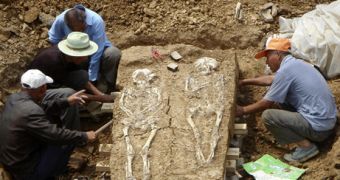Human sacrifices have been made in almost any human civilization. China is no exception.
Chinese archaeologists have unearthed two human skeletons from a tomb in Fengyang, China. The tomb dates from the Qin dynasty period (221 to 206 B.C.). This dynasty is the first to have unified China and this is where the western name of China (Chinese people call themselves Han) comes from. The tomb contained nine people thought to have been buried alive together with the corpses of the[admark=1] dead.
Digging also exposed bronze cooking vessels and chimes.
The Qin dynasty is also famous for the army of terracotta warriors and horses. Fengyang is more known as the hometown of Emperor Zhu Yuanzhang (1328-1398), the Ming-dynasty founder who chased away the Mongols from China in 1368. The Mongols, nomadic steppe warriors from the north, had ruled China as the Yuan dynasty since the conquest of China by Genghis Kahn in 1271.
Another tomb, even older, has been excavated in northwest China's Shaanxi Province, close to the Yellow River, dated to the Zhou Dynasty (1046 BC-221 BC).
The archaeologists found four colored wooden tomb figures, about 80 centimeters tall, which can be 500 years older than the famous terracotta army. The figures were placed at the four corners of the tomb. The wooden tomb figures have rotted and turned into clay tomb figures and the researchers are now planning to recast them with plaster and reagent.
Tomb figures had a human shape and were made of wood, earth, terracotta or stone, being buried with the dead in ancient times. When the human sacrifice was made people were buried alive together with the dead ones.
The excavation work started in April 2005 on the tombs in the Liangdai village. The diggings have revealed a lot of precious cultural relics, including gold, copper and jade and iron wares.

 14 DAY TRIAL //
14 DAY TRIAL //